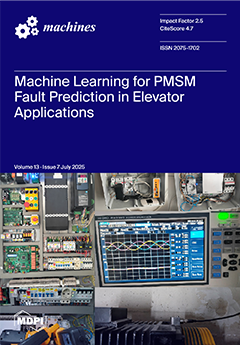As a key component in the hydraulic brake system of automobiles, the brake joint directly affects the braking performance and driving safety of the vehicle. Therefore, improving the quality of brake joints is crucial. During the processing, due to the complexity of the
[...] Read more.
As a key component in the hydraulic brake system of automobiles, the brake joint directly affects the braking performance and driving safety of the vehicle. Therefore, improving the quality of brake joints is crucial. During the processing, due to the complexity of the welding material and welding process, the weld seam is prone to various defects such as cracks, pores, undercutting, and incomplete fusion, which can weaken the joint and even lead to product failure. Traditional weld seam detection methods include destructive testing and non-destructive testing; however, destructive testing has high costs and long cycles, and non-destructive testing, such as radiographic testing and ultrasonic testing, also have problems such as high consumable costs, slow detection speed, or high requirements for operator experience. In response to these challenges, this article proposes a defect detection and classification method for laser welding seams of automotive brake joints based on machine vision inspection technology. Laser-welded automotive brake joints are subjected to weld defect detection and classification, and image processing algorithms are optimized to improve the accuracy of detection and failure analysis by utilizing the high efficiency, low cost, flexibility, and automation advantages of machine vision technology. This article first analyzes the common types of weld defects in laser welding of automotive brake joints, including craters, holes, and nibbling, and explores the causes and characteristics of these defects. Then, an image processing algorithm suitable for laser welding of automotive brake joints was studied, including pre-processing steps such as image smoothing, image enhancement, threshold segmentation, and morphological processing, to extract feature parameters of weld defects. On this basis, a welding seam defect detection and classification system based on the cascade classifier and AdaBoost algorithm was designed, and efficient recognition and classification of welding seam defects were achieved by training the cascade classifier. The results show that the system can accurately identify and distinguish pits, holes, and undercutting defects in welds, with an average classification accuracy of over 90%. The detection and recognition rate of pit defects reaches 100%, and the detection accuracy of undercutting defects is 92.6%. And the overall missed detection rate is less than 3%, with both the missed detection rate and false detection rate for pit defects being 0%. The average detection time for each image is 0.24 s, meeting the real-time requirements of industrial automation. Compared with infrared and ultrasonic detection methods, the proposed machine-vision-based detection system has significant advantages in detection speed, surface defect recognition accuracy, and industrial adaptability. This provides an efficient and accurate solution for laser welding defect detection of automotive brake joints.
Full article





